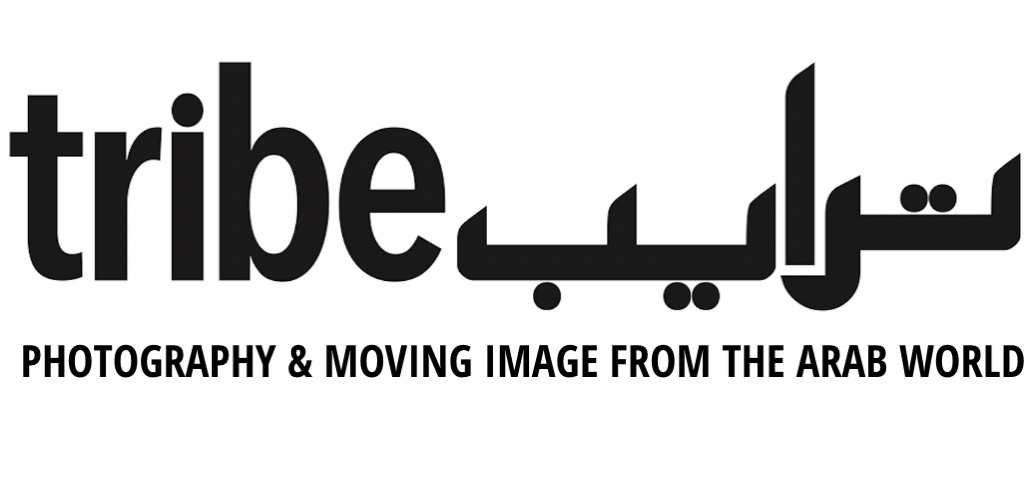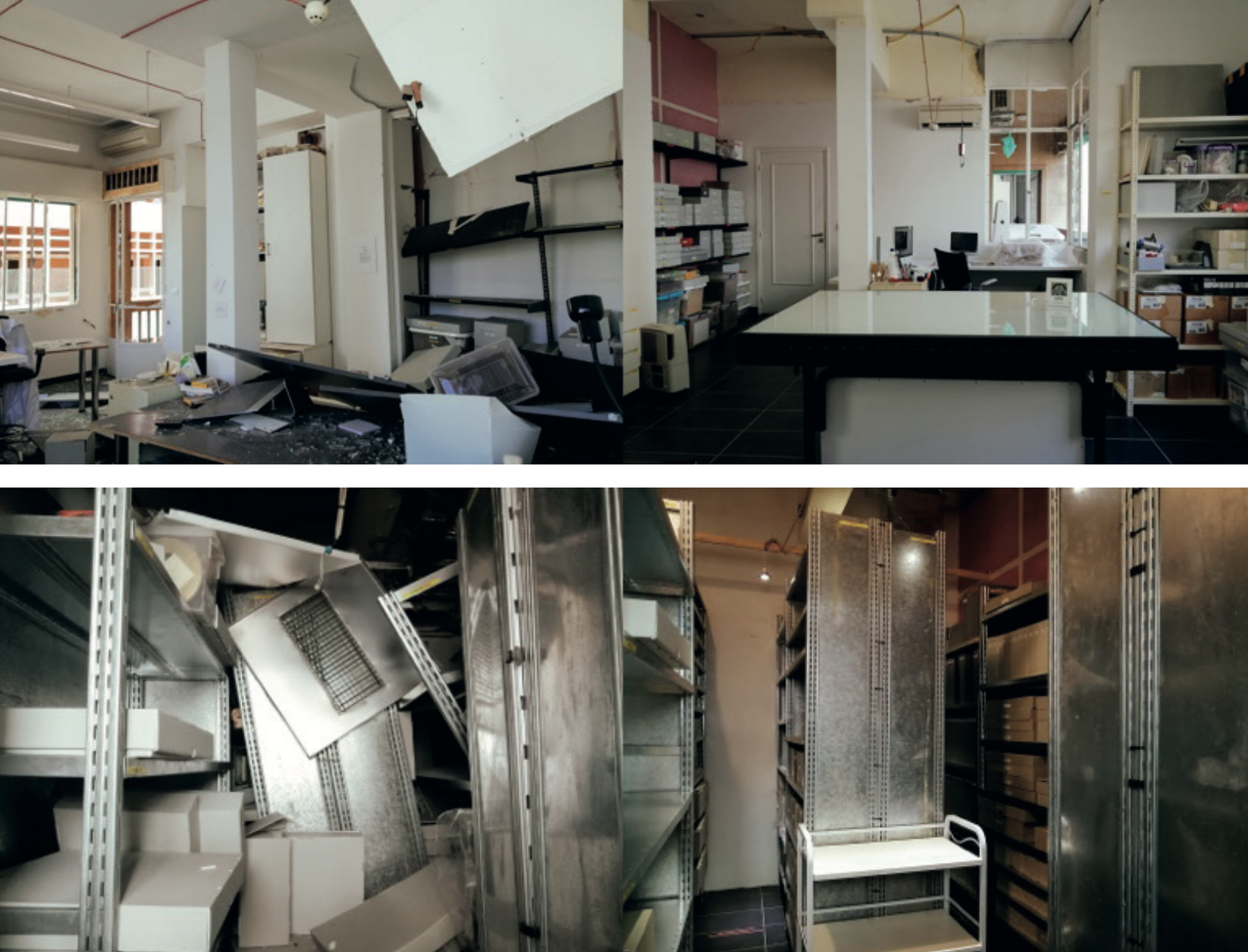A Conversation with Arab Image Foundation’s Heba Hage-Felder
Collections in the cool storage room and preservation department were moved to the digitization lab. The lab was the first room to be stabilized and served as a makeshift storage space until reconstruction works were complete. In this photo, archivists Rachel Tabet and Charbel Al Khoury work on assessing the damage to the collections. Photograph by Christopher Baaklini, courtesy of the Arab Image Foundation.
With text by Farrah Berrou
In March 2021, six months after the devastating August 4 port blast that decimated the Lebanese capital, Farrah Berrou spoke with Heba Hage- Felder, director of Arab Image Foundation (AIF), via Zoom to check in on the progress of the organization’s clean-up and reopening efforts, and the morale of its team.
Formerly the head of institutional development, fundraising, and management of new programs at the Arab Fund for Arts and Culture (AFAC), Heba Hage-Felder was hired as the new director of Beirut’s Arab Image Foundation. But just three days after introducing herself to the team to discuss next steps, a massive explosion tore through the heart of the capital city. AIF, established in 1997, sits 800m away from the port, where 2,750 tons of ammonium nitrate were being unsafely stored. Essentially, Hage-Felder’s first two months on the job involved handling mind- numbing devastation in a country already grappling with economic and health crises. For an organization dedicated to preserving a massive collection of visual keepsakes from the Middle East, North Africa, and the Arab diaspora, such an explosion was an unthinkable disaster.
But thanks to an emergency plan set up prior to the blast, the majority of the Arab Image Foundation’s collection, as well as its custodians, managed to survive the impact with a mere three items out of its 500,000 damaged. According to Hage-Felder, the question of how best to safeguard precious ephemera was always present in the minds of AIF team members, which is what led to their simple yet necessary emergency plan with the help of a FIDA grant and the support of the Norwegian Embassy. Included in that plan was this whole aspect of, “From the moment you receive the collection, what is it that one should do to make sure that, wherever it sits in the office, it’s protected?” said Hage-Felder.
An institution anywhere must prepare for all worst- case scenarios, whether natural or site-specific. From earthquakes to electricity cuts, like the ones Lebanon frequently experiences, the possible risks for permanent loss or damage can be endless and, frankly, unpredictable. Hage-Felder explained that basic preventative steps were implemented, which could be the reason for the collection’s survival. After all, as she said, “Always with a disaster, the first responders are those who are based where the disaster happens,” and so they must have a schematic in place just like the ones on the back of hotel room doors.
As part of its collection’s management strategy, the AIF team set up protocols for how items were placed in boxes, where those were then placed (heavier ones on lower shelves), and how they were secured to shelves (bungee cords). The added layer of protection was the development of digital surrogate copies with the digitizing of as much of the collection as possible (80 of 306 collections have been digitized so far). Storing properly packed drives on- and off-site at peer institutions (underground at the neighboring Sursock Museum) was another backup method in case the Foundation’s location was compromized.
Arab Image Foundation has become a crash test dummy for catastrophe, and its preservation practices were put to the ultimate test that day in August. “You always think, ‘Okay, I have a plan, I hope I never put it to the test.’ Butwehadtoanditwasagoodwaytogobackand say, what worked? Were we offbeat? Did we really put in place the things that would help us deal with such a crisis?” said Hage-Felder. In what is perhaps the silver lining of this horrendous event, AIF can now be used as a case study of effective preservation techniques for other institutions around the world. In October 2020, ithosted a one-week training session with colleagues at Yemen’s Basement Cultural Foundation.
Hage-Felder said that digitizing can also be another way to preserve the collection, because it becomes more accessible for repurposing. “Philosophically, the vision of making these collections accessible to users, to researchers, to artists, and to photography-lovers is a way of prolonging their life.”
It is not all that romantic. The port blast was sudden and it has been left unresolved for months. No one has been held accountable, resulting in no justice and no closure, and has left people and institutions alike with unanswered questions and the inability to see the road ahead. But it is not for a lack of trying. “Something as simple as an annual plan became a pillar to hang onto because it’s what kept us going in the middle of this insanity that we’re living,” Hage-Felder claimed.
“In history,” she elaborated, “there have been many traumatic events and we’ve lived to learn about them so something has to continue. It’s very much the life of a photograph in that sense, metaphorically. From the minute a photograph is taken and if it’s 100 years ago, the photograph itself goes through war or famine, or a family having to migrate and become refugees, etc. There are so many stories that are in these inanimate objects that are very telling and that give you a sense of—it’s not about my life or the duration of my life but it’s about a story that needs to be continuously told andso, what is your role in it? In this very existential moment, this very surreal moment.”
AIF’s staff continues to receive support from its board, and the many artists and researchers that see value in the Foundation’s existence. But in all this uncertainty, the strongest testament to the Foundation’s purpose after twenty-four years of operation still flows in, as image and research requests continue to come in from across the globe.
“It’s a niche,” said Hage-Felder, “but at the same time, it’s a language that a lot of people understand and can talk about with so much joy and passion, very much like other artistic disciplines.” She went on to invoke a lyric from a Fairouz song, “At the end of the day, everything that’s left is a bunch of photographs and a few stories.”
Something as forceful as a non-nuclear explosion can shake foundations, both structural and institutional. It can leave a team feeling like the objects in its care are fickle and their painstaking preservation is futile. But that is also why this work is so necessary. We are nothing but what we leave behind and the stories that are locked within.
These collective treasures are fragile and at constant risk of being lost. That is why they need to be protected.
Future plans for AIF include reviving pre-blast plans of relocating to a bigger and more robust space to accommodate more visitors, revamping the online platform to make it more user-friendly, upgrading the cool storage room to make it energy-efficient, and launching new programing. It also hopes to maintain momentum on existing plans like the online newsletter and Lamha, the monthly podcast of three-minute episodes that spotlights a collection and its story and/ or photographer. It also hopes to process three of the pending collections which are particularly unique due to the era, type of photography, and archival method of the photographers themselves.
Before and after shots of the preservation department. The work table that used to be in the middle could not be salvaged, so we replaced it with our large lightbox and reshuffled our desks.
Above left: pending collections now sit on open shelves because the closet was destroyed. Above right: our new preservation table, which we put together by borrowing two desks from the digitization department.
Below left and right: Before and after view of the CSR. The fake ceiling has been removed and light fixtures are hanging from DIY wooden bars.



